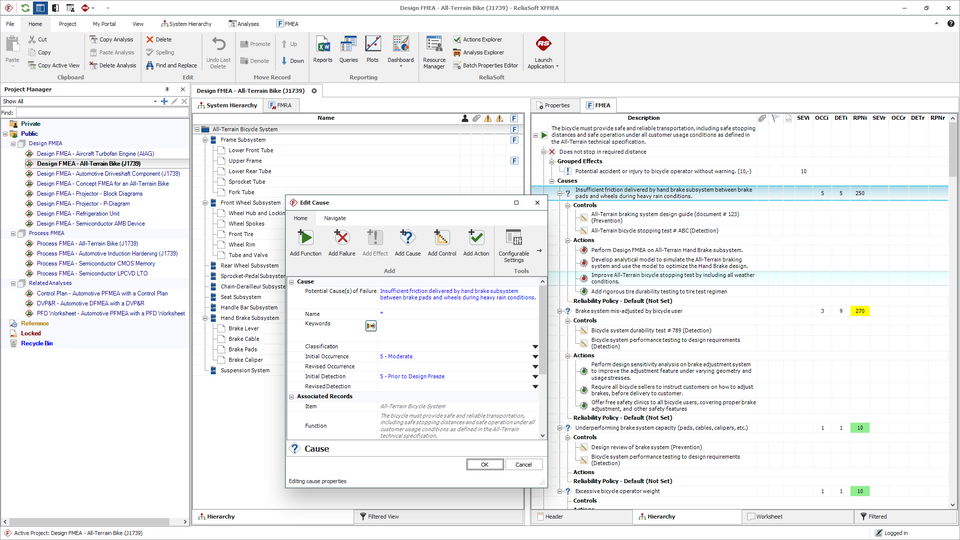

Create any type of FMEA, discover high risk items, and prioritize issues of potential failures
ReliaSoft XFMEA software allows you to perform any type of FMEA analysis, including Design FMEA, System FMEA, Process FMEA and FMECA. With extensive reporting capabilities, risk discovery tool and flexibility to accommodate all FMEA techniques, you can facilitate any FMEA team workshops/meetings. You can easily link the FMEA analysis to reliability block diagrams (RBDs) and fault trees, and transform the FMEA findings into a representative reliability model of your system. The software enables you to build a continuous knowledge repository of the FMEA results to be reused throughout the reliability program. It also supports related analyses such as P-Diagrams, DVP&Rs (Test Plans), Design Reviews Based on Failure Mode (DRBFMs), Process Flow Diagrams and Process Control Plans.

Discover What's New in ReliaSoft 2021 >
Discover key XFMEA capabilities for product and process improvement
Establish consistency throughout your organisation's FMEA process. Enable cooperation across multiple users to quickly analyse current designs and processes to improve efficiency and reduce costs.
Increase customer satisfaction by performing any FMEA and FMECA to achieve higher reliability and safety. Highlight high risk items using Criticality Analysis or Risk Priority Number (RPN).
Proactively consider potential failures, prioritise issues based on risk, and then initiate improvements early in development when modifications tend to have the greatest impact for the lowest cost.
Bolster your quality, risk and reliability programs by supporting industry standards for all types of FMEA analysis, including predefined profiles for AIAG & VDA, SAE J1739, IEC 60812, ISO 14971, VDA-4 (German Automotive Industry), and MIL-STD-1629A.
Save time and promote consistency within your organisation by reusing information and libraries from existing FMEAs. Easily trace and search your reliability knowledge base.
Effectively support decision-making and make sure that corrective actions are implemented by utilising utilise charts, reports, automated e-mails, and other features to optimally use your analysis information.
See All Functionality
FMEA standards
XFMEA supports the major industry standards for all types of FMEA analysis (including Design FMEA, Process FMEA, FMECA, etc.). The software provides predefined profiles for the major reporting standards and offers extensive capabilities to customize the interface and reports to meet your organization's specific needs.
- AIAG & VDA 1st Edition
- SAE J1739
- IEC 60812
- ISO 14971
- VDA-4 (German Automotive Industry)
- MIL-STD-1629A

Support for all types of FMEA
XFMEA supports all types of FMEA analysis and provides extensive customization options to fit your analysis and reporting needs.
- Design FMEA (DFMEA)
- Process FMEA (PFMEA)
- System FMEA
- FMECA
Risk assessment methods
The software makes it easy to configure the analysis project to fit any of the risk assessment methodologies that are commonly employed in conjunction with FMEA.
- Configurable risk mitigation tools are available to evaluate risk based on Severity X Occurrence, Risk Priority Numbers (RPNs) and risk matrixes.
- Priority Highlights feature allows you to highlight issues based on specified criteria. This includes a customizable Risk Ranking Logic option that allows you to define both the priority levels and the logic used to assign certain issues to each level.
- Multiple severity scores per effect allows you to rate effects according to several different types of severity and then use the sub-severity ratings to calculate an overall severity rating for each effect, based on either the maximum or the average of the sub-severity ratings (except for grouped effects).
- XFMEA continues to provide support for both quantitative and qualitative Criticality Analysis patterned after MIL-STD-1629A. Instead of relying only on the assumption of an exponential distribution, XFMEA allows you to consider time-dependent distributions for describing the reliability/probability of failure.
- Quantitative Consequence Priority Numbers (QCPNs) is based on quantitative values associated with each rating in the severity, occurrence and detection rating scales.
- The Alpha/Beta Ratios criticality worksheet is used to calculate the likelihood of each effect occurring, assuming a known overall failure rate for the item.
P-Diagrams
Parameter Diagram (P-Diagram) is a structured tool that identifies the inputs from a system and relates those inputs to the desired system outputs, while considering the controlled and uncontrolled factors. It is useful in brainstorming and documenting input signals, noise factors, control factors, error states and ideal responses, and helps the FMEA team understand and make visible the robustness of the design that is being analyzed. It can provide important input to System and Design FMEAs.
Transfer Design FMEA to Process FMEA
Transferring relevant data from the Design FMEA can provide a useful starting point for a new Process FMEA. Flexible Transfer Projects utility allows you to specify what information will be transferred and how it will be mapped to the new analysis.
Process Control Plans (PCPs)
The Control Plan utility provides a configurable worksheet for process control plans. You can create a plan from scratch or import data from Excel. You also can transfer data from the FMEA that has been defined for the same item.
Process Flow Diagrams (PFDs)
A process flow diagram provides a logical, visual depiction of the process that is being analyzed. XFMEA allows you to integrate the diagram into a worksheet that captures more specific details about each step in the process. This worksheet records the specific operations that are performed and starts to identify the key product/process characteristics that need to be kept under control during manufacturing. XFMEA makes it easy to automatically transfer relevant data to the Process FMEA (PFMEA) and process control plan.
Design Reviews Based on Failure Mode (DRBFMs)
You can use the design review based on failure mode (DRBFM) methodology to evaluate proposed changes to an existing design. The DRBFM utility provides a configurable worksheet patterned after the method developed within Toyota Motor Corporation. The software makes it easy to import selected functions from an existing FMEA and to append selected data from the DRBFM to update the FMEA.
Data management tools
Flexible data management capabilities can save time on data entry, help to ensure consistency among analyses and even provide brainstorming tools that will improve the quality of your FMEAs. The software provides an array of tools to help you find and reuse descriptions from any existing analysis and to select phrases from predefined templates or phrase libraries. You also can use fully customisable Excel® templates to quickly import system configurations or analysis data from external data sources.
- Customised templates for imports, queries and reports
- Change log
- Analysis planning tool
- Links and attachments
- Find and replace
- Action alerts via e-mail, SMS text message or portal message
- Cause and effect diagrams
- Ability to track ancestry of each record
Failure Modes and Reliability Analysis (FMRA)
The failure modes and reliability analysis (FMRA) feature helps you to integrate statistical reliability analysis calculations into your FMEA activities. Specifically, this view can be used to:
- Display all of the FMEA records that could have an impact on system reliability in a single hierarchical tree and use this view to define the relevant reliability characteristics.
- Calculate the probabilities of failure required for a quantitative criticality analysis.
- Use the occurrence ratings that have been defined in the FMEA to generate a preliminary baseline reliability estimate for the system that can be improved later when actual failure data become available.
- Synchronise with BlockSim’s reliability block diagrams (RBDs) or fault trees, which facilitate more realistic system modeling (e.g., by considering redundancy, common cause failures, etc.).
- Allocate the target reliability and target availability. You can also push the calculated reliability/availability to metrics that allow you to display the information in other locations and track how the value has changed over time.
Queries, reports, charts and diagrams
You can generate reports in the tabular worksheet format that is commonly used for FMEAs and related analyses. However, because all the analysis information is stored in a relational database, XFMEA is able to go beyond these basic worksheets to provide a complete range of options for presenting the data in ways that will effectively communicate results and facilitate decision-making.
Configurable queries and print-ready reports
Use the Templates Manager to manage predefined and customised templates that can be made available to all database users, applied to any data set and incorporated into any print-ready report document.
- The Query Utility window is a powerful analysis tool that makes it easy to find and open specific sections of the analysis. It is also a flexible custom reporting tool that allows you to create and manage saved queries that meet your presentation requirements.
- The Reports window makes it easy to build report documents that include the predefined report forms, custom report forms and/or custom queries that will be most effective to present your analysis results. Since you can generate these documents directly in Microsoft Word or Excel, it is easy to customise and distribute reports without a specialised report editor or viewer. Click here to view sample reports.
You can save generated reports with the project, which enables all users to view/print the same report documents. If your organisation chooses to implement SEP - web portal for ReliaSoft applications, you can also publish these reports to the portal (in Word, Excel, PDF or MHTML format), where they can be accessed from any web-enabled device.
FMEA/FMRA dashboards
You can create customised dashboards to present data from FMEA and FMRA analyses in XFMEA/RCM++/RBI. In addition, if your organisation chooses to implement a web-based portal for an enterprise database, you can now share selected dashboards to be accessed from any web-enabled device.
Ancestry
The Ancestry Association Status in the system hierarchy is used to summarize the ancestry status of all associated record for that item. The status icons in the system hierarchy indicate the status of all associations that apply to the item. If the source record (or one of its dependents) for any descendant record included in the item's FMEA or test plan has changed, or if any source record has been deleted, the icon will be orange. A green icon indicates that no source records have been changed either since their descendants were created or since the last time a change notification for the descendants was dismissed.
Additionally, the ancestry information window can display when and by who the associated record was last updated.

Improve corporate-wide FMEA collaboration with SEP web portal
Enhance your future design and product improvements with XFRACAS
ReliaSoft XFRACAS is a web-based incident (failure) reporting, analysis and corrective action system designed for the acquisition, management and analysis of product quality and reliability data from multiple sources. Closing the loop between your FMEA and FRACAS can be very beneficial, providing significant improvements for future design efforts. Share data, system configurations and failure mode data between XFRACAS and the analyses that you perform in XFMEA to support decision making process and corrective action implementation plans.






